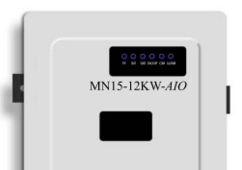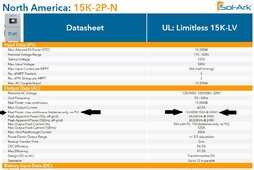Actually, it’s 48kW with grid assist.Remember that the 15K is actually 12KW except for during the day.
You are using an out of date browser. It may not display this or other websites correctly.
You should upgrade or use an alternative browser.
You should upgrade or use an alternative browser.
Midnite Solar Announced their new 10kw AIO at Intersolar Today
- Thread starter HighTechLab
- Start date
Midnite Beta Tester
Just Testing
Looks entirely 12kW batteries only, no PV according to the spec sheet...Not entirely.
This is why I would like to start referring to the inverters by their Current capabilities.
210a for MN AIO
250a for EG4 18kPV
275a for SolArk 15k
Attachments
42OhmsPA
What's in a title?
Midnite over solark all Deye. 
Zwy
Emperor Of Solar
You gave me an option on my shop as loads are mainly during the day. Cloudy days might not be so good though.Oh, I see what you mean now. 120a charging is quite low. I'm surprised at that.
But it gets the wheels turning.
that is one thing I like about ac coupling. during the daytime my battery inverter does basically nothing except charge the battery and when the battery is full its doing no work as the pv inverter carries all the load.You gave me an option on my shop as loads are mainly during the day. Cloudy days might not be so good though.
But it gets the wheels turning.
Lt.Dan
Solar Wizard
As for a person who has tested it several times, I can tell you its not limited at 12kw. There is also a couple guys here on the forums running 17s batteries, the SolArk is absolutley capable of more than 12kw. It is limited at 275a, so if you run 17s, you can get the true 15kw at nominal battery voltage.Looks entirely 12kW batteries only, no PV according to the spec sheet...
This has been gone over in other threads a few different times.
EDIT: I'm not knocking the Midnight AIO. I absolutely can't wait for it to come out and see how it does. The surge capacity on one leg far surpasses anything else on the market, and that is absolutely outstanding.
timselectric
If I can do it, you can do it.
- Joined
- Feb 5, 2022
- Messages
- 18,766
Yes, the Sol-Ark "15k" can actually output 15k if......
The grid is helping
Or a generator is helping
Or it's a bright sunny day
Or you use a higher (than normal) voltage battery
But , these are things that should get you more than expected.
They should not be required just to live up to its name.
The grid is helping
Or a generator is helping
Or it's a bright sunny day
Or you use a higher (than normal) voltage battery
But , these are things that should get you more than expected.
They should not be required just to live up to its name.
Lt.Dan
Solar Wizard
I don't want to continue to derail the thread. We can continue this elsewhere if someone else needs to.
Wrapping back to the pics that @HighTechLab posted in the OP. I see the screen in the middle, but are the buttons up at the top? Its hard to tell in the pic.
Wrapping back to the pics that @HighTechLab posted in the OP. I see the screen in the middle, but are the buttons up at the top? Its hard to tell in the pic.
I get where you are coming from on the 275A rating (vs. 250A or 210A etc.), But has anyone done long term amp tests on Sol-Ark 15K and/or Eg4 18K? I have heard that on charging, the 15K is quickly derating charge current to less than 275A due to temps. In fact one person that I know with a bit of 15K experience (dealer with SA15K in their showroom, fully off-grid) looked at me as if I was joking when I mentioned 275A of charging from a 15K.As for a person who has tested it several times, I can tell you its not limited at 12kw. There is also a couple guys here on the forums running 17s batteries, the SolArk is absolutley capable of more than 12kw. It is limited at 275a, so if you run 17s, you can get the true 15kw at nominal battery voltage.
I would imagine discharge amps would end up with similar results to charge amps, as far as temp derating goes.
Forgive me if this has been discussed in other posts ion the forum. I didn't even check.
Another thing to consider, as far as kW of output. Despite the fact that it's possible to run 17s configuration to gain on output, the ratings need to be based on "normal" installs. And 17s will not be a "normal" install. Any "48v" LifePo4 battery that someone buys "off-the-shelf" will be 16s. And as such, ratings NEED to be based off that.
I agree with @timselectric that you should not need to manipulate things to get nameplate ratings!
It all gets a little fuzzy with an AIO, because of how the flow of power is inside of them. But at the end of the day, whatever the nameplate says, should be "nominal output", eg: output capability under worst case scenarios, NOT best case scenarios, let alone "unique/custom" scenarios!
I don't want to continue to derail the thread. We can continue this elsewhere if someone else needs to.
Wrapping back to the pics that @HighTechLab posted in the OP. I see the screen in the middle, but are the buttons up at the top? Its hard to tell in the pic.

Looks like, indicator lights up top.
I assume it's a touch screen.
Hedges
I See Electromagnetic Fields!
- Joined
- Mar 28, 2020
- Messages
- 20,804
Names have no legal meaning. Unless the courts step in and prohibit a cable operator from referring to its 10 gigabit service as "10G" which sounds to customers like better than "5G". (Of course, everyone knows that a 1/4 pounder is better than a 1/3 pounder, because 4 is bigger than 3; the customers weren't born yesterday.)
Data sheet specs are something it has to meet. But may not give conditions. We assume 25C ambient temperature, and continuous output unless otherwise stated.
Some brands will give continuous rating, power vs. time rating, power vs. temperature derating.
I^2R heating is going to limit power output and charging. We expect quoted nominal specs to be met continuous. "peak" could quote higher transients.
Operation over voltage range seems to be the wild card. PV from say 150V to 550V? Efficiency changes, therefore derating.
Battery from say 42V to 60V? Efficiency and wattage output will vary.
What we expect is a wattage rating for inverter, for charger, for MPPT, with voltage range over which it is valid at nominal temperature.
These AIO legitimately have three separate specs: PV to HV DC rail wattage, battery to/from DC rail wattage, DC rail to/from AC output wattage.
It is quite useful to have PV power handling in excess of inverter capacity. SMA's soon to be available SBSE processes PV wattage 200% of inverter wattage. It's name is based on AC wattage.
Data sheet specs are something it has to meet. But may not give conditions. We assume 25C ambient temperature, and continuous output unless otherwise stated.
Some brands will give continuous rating, power vs. time rating, power vs. temperature derating.
I^2R heating is going to limit power output and charging. We expect quoted nominal specs to be met continuous. "peak" could quote higher transients.
Operation over voltage range seems to be the wild card. PV from say 150V to 550V? Efficiency changes, therefore derating.
Battery from say 42V to 60V? Efficiency and wattage output will vary.
What we expect is a wattage rating for inverter, for charger, for MPPT, with voltage range over which it is valid at nominal temperature.
These AIO legitimately have three separate specs: PV to HV DC rail wattage, battery to/from DC rail wattage, DC rail to/from AC output wattage.
It is quite useful to have PV power handling in excess of inverter capacity. SMA's soon to be available SBSE processes PV wattage 200% of inverter wattage. It's name is based on AC wattage.
Zwy
Emperor Of Solar
The 6000XP in a pair would fit well. I run my house and well of the LV6548's and never have a problem with running out of capability. If I was completely off grid without grid backup, I'd seriously consider the four 6000XP. One doesn't need many features and it would give the ability to keep power on if one unit failed.Not totally off grid, I just do not want anything related to Export, I do not have an interconnect with the PoCo. I want to store all my energy on site ... BUT ... I want to have grid interactive and pass thru features such as being able to switch back to grid automatically when the battery drops below a set SOC, or the ability to load support with grid (features like the Schneider XW Pro).
Zwy
Emperor Of Solar
I'm not certain of that, and would like some clarification. I looked at the spec sheet for Midnight AIO and it might be 6Kw per leg continuous with a 13Kw surge. Output is rated at 47.5A per leg which is 6Kw.EDIT: I'm not knocking the Midnight AIO. I absolutely can't wait for it to come out and see how it does. The surge capacity on one leg far surpasses anything else on the market, and that is absolutely outstanding.
Maybe Robin or Bob could comment on this?
I’d wait for their 8kw version simply due to the larger PV input capacity. Can run parallel strings and not cap amperage so easily to bootThe 6000XP in a pair would fit well. I run my house and well of the LV6548's and never have a problem with running out of capability. If I was completely off grid without grid backup, I'd seriously consider the four 6000XP. One doesn't need many features and it would give the ability to keep power on if one unit failed.
Day 29 of me waiting patiently for a price or eta of when these will be released into the wild!
Not harping on midnite, just trying to stay on topic lol. It could have less capacity and be priced more than anything eg4 or solark sells and have zero reviews and it’d still jump ahead of them on my list. I guess that makes me a fanboy
Not harping on midnite, just trying to stay on topic lol. It could have less capacity and be priced more than anything eg4 or solark sells and have zero reviews and it’d still jump ahead of them on my list. I guess that makes me a fanboy
Brucey
Solar Wizard
Was there a list of the specs for an 8000XP?I’d wait for their 8kw version simply due to the larger PV input capacity. Can run parallel strings and not cap amperage so easily to boot
Partimewages
Solar Addict
5 out of 4 people have trouble with fractions!Names have no legal meaning. Unless the courts step in and prohibit a cable operator from referring to its 10 gigabit service as "10G" which sounds to customers like better than "5G". (Of course, everyone knows that a 1/4 pounder is better than a 1/3 pounder, because 4 is bigger than 3; the customers weren't born yesterday.)
Data sheet specs are something it has to meet. But may not give conditions. We assume 25C ambient temperature, and continuous output unless otherwise stated.
Some brands will give continuous rating, power vs. time rating, power vs. temperature derating.
I^2R heating is going to limit power output and charging. We expect quoted nominal specs to be met continuous. "peak" could quote higher transients.
Operation over voltage range seems to be the wild card. PV from say 150V to 550V? Efficiency changes, therefore derating.
Battery from say 42V to 60V? Efficiency and wattage output will vary.
What we expect is a wattage rating for inverter, for charger, for MPPT, with voltage range over which it is valid at nominal temperature.
These AIO legitimately have three separate specs: PV to HV DC rail wattage, battery to/from DC rail wattage, DC rail to/from AC output wattage.
It is quite useful to have PV power handling in excess of inverter capacity. SMA's soon to be available SBSE processes PV wattage 200% of inverter wattage. It's name is based on AC wattage.
Brucey
Solar Wizard
Just for the lux labeled oneWas there a list of the specs for an 8000XP?
I have never heard of anyone having problems with charging throttling (I have never seen it with mine). What are his ambient temps?I get where you are coming from on the 275A rating (vs. 250A or 210A etc.), But has anyone done long term amp tests on Sol-Ark 15K and/or Eg4 18K? I have heard that on charging, the 15K is quickly derating charge current to less than 275A due to temps. In fact one person that I know with a bit of 15K experience (dealer with SA15K in their showroom, fully off-grid) looked at me as if I was joking when I mentioned 275A of charging from a 15K.
I would imagine discharge amps would end up with similar results to charge amps, as far as temp derating goes.
Forgive me if this has been discussed in other posts ion the forum. I didn't even check.
Another thing to consider, as far as kW of output. Despite the fact that it's possible to run 17s configuration to gain on output, the ratings need to be based on "normal" installs. And 17s will not be a "normal" install. Any "48v" LifePo4 battery that someone buys "off-the-shelf" will be 16s. And as such, ratings NEED to be based off that.
I agree with @timselectric that you should not need to manipulate things to get nameplate ratings!
It all gets a little fuzzy with an AIO, because of how the flow of power is inside of them. But at the end of the day, whatever the nameplate says, should be "nominal output", eg: output capability under worst case scenarios, NOT best case scenarios, let alone "unique/custom" scenarios!
Similar threads
- Replies
- 3
- Views
- 293
- Replies
- 5
- Views
- 641
- Replies
- 4
- Views
- 537




